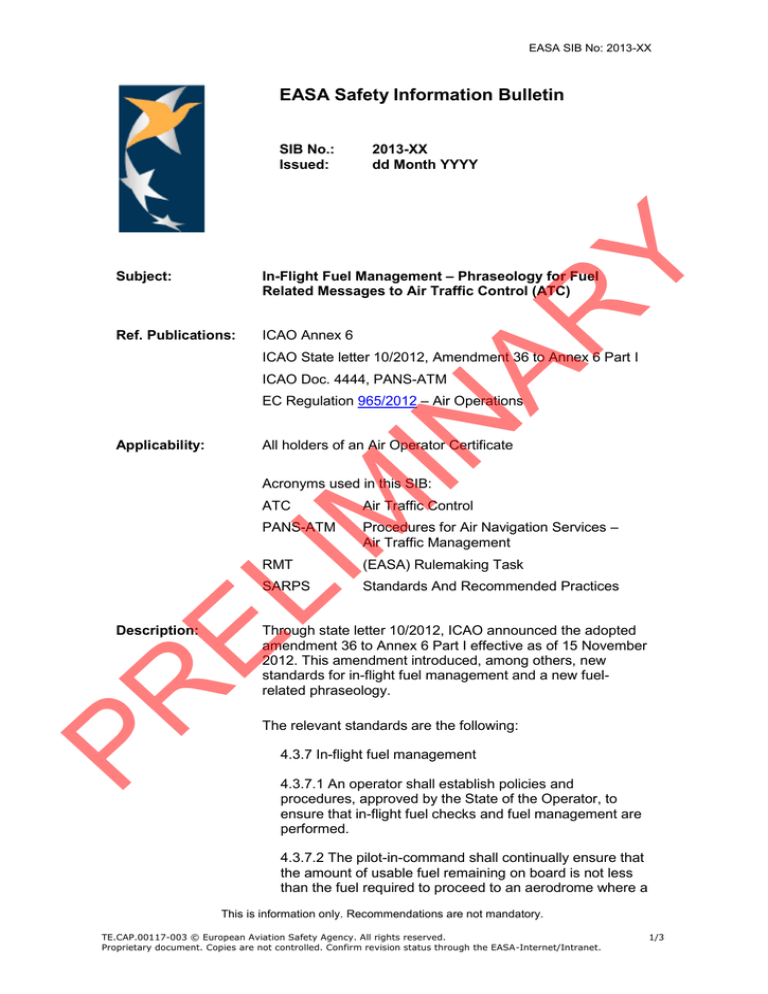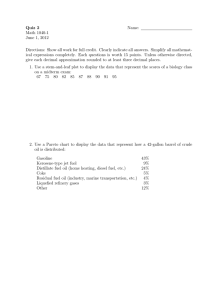
EASA SIB No: 2013-XX
EASA Safety Information Bulletin
2013-XX
dd Month YYYY
Y
SIB No.:
Issued:
In-Flight Fuel Management – Phraseology for Fuel
Related Messages to Air Traffic Control (ATC)
Ref. Publications:
ICAO Annex 6
IN
AR
Subject:
ICAO State letter 10/2012, Amendment 36 to Annex 6 Part I
ICAO Doc. 4444, PANS-ATM
EC Regulation 965/2012 – Air Operations
Applicability:
All holders of an Air Operator Certificate
IM
Acronyms used in this SIB:
Air Traffic Control
PANS-ATM
Procedures for Air Navigation Services –
Air Traffic Management
RMT
(EASA) Rulemaking Task
SARPS
Standards And Recommended Practices
EL
ATC
PR
Description:
Through state letter 10/2012, ICAO announced the adopted
amendment 36 to Annex 6 Part I effective as of 15 November
2012. This amendment introduced, among others, new
standards for in-flight fuel management and a new fuelrelated phraseology.
The relevant standards are the following:
4.3.7 In-flight fuel management
4.3.7.1 An operator shall establish policies and
procedures, approved by the State of the Operator, to
ensure that in-flight fuel checks and fuel management are
performed.
4.3.7.2 The pilot-in-command shall continually ensure that
the amount of usable fuel remaining on board is not less
than the fuel required to proceed to an aerodrome where a
This is information only. Recommendations are not mandatory.
TE.CAP.00117-003 © European Aviation Safety Agency. All rights reserved.
Proprietary document. Copies are not controlled. Confirm revision status through the EASA-Internet/Intranet.
1/3
EASA SIB No: 2013-XX
safe landing can be made with the planned final reserve
fuel remaining upon landing.
4.3.7.2.1 The pilot-in-command shall request delay
information from ATC when unanticipated circumstances
may result in landing at the destination aerodrome with
less than the final reserve fuel plus any fuel required to
proceed to an alternate aerodrome or the fuel required to
operate to an isolated aerodrome.
IN
AR
Y
4.3.7.2.2 The pilot-in-command shall advise ATC of a
minimum fuel state by declaring MINIMUM FUEL when,
having committed to land at a specific aerodrome, the pilot
calculates that any change to the existing clearance to that
aerodrome may result in landing with less than planned
final reserve fuel.
Note 1.— The declaration of MINIMUM FUEL informs ATC
that all planned aerodrome options have been reduced to
a specific aerodrome of intended landing and any change
to the existing clearance may result in landing with less
than planned final reserve fuel. This is not an emergency
situation but an indication that an emergency situation is
possible should any additional delay occur.
EL
IM
Note 2.— Guidance on declaring minimum fuel is
contained in the Fuel Planning Manual (Doc 9976). It
should be noted that Pilots should not expect any form of
priority handling as a result of a “MINIMUM FUEL”
declaration. ATC will, however, advise the flight crew of
any additional expected delays as well as coordinate when
transferring control of the aeroplane to ensure other ATC
units are aware of the flight’s fuel state.
PR
4.3.7.2.3 The pilot-in-command shall declare a situation of
fuel emergency by broadcasting MAYDAY, MAYDAY,
MAYDAY, FUEL, when the calculated usable fuel
predicted to be available upon landing at the nearest
aerodrome where a safe landing can be made is less than
the planned final reserve fuel.
Note 1.— The planned final reserve fuel refers to the value
calculated in 4.3.6.3 e) 1) or 2) and is the minimum amount
of fuel required upon landing at any aerodrome.
Note 2.— The words “MAYDAY FUEL” describe the nature
of the distress conditions as required in Annex 10, Volume
II, 5.3.2.1, b) 3.
Note 3.— Guidance on procedures for in-flight fuel
management are contained in the Fuel Planning Manual
(Doc 9976).
The corresponding provisions for controllers can be found in
15.5.4 of PANS-ATM.
This is information only. Recommendations are not mandatory.
TE.CAP.00117-003 © European Aviation Safety Agency. All rights reserved.
Proprietary document. Copies are not controlled. Confirm revision status through the EASA-Internet/Intranet.
2/3
EASA SIB No: 2013-XX
EC Regulation 965/2012 does not yet require that the pilot-incommand / commander shall:
Request delay information from ATC;
Advise ATC of a minimum fuel state by declaring
MINIMUM FUEL; and
Declare a situation of fuel emergency by broadcasting
MAYDAY MAYDAY MAYDAY FUEL.
Y
EASA will propose the necessary amendments of EC
Regulation 965/2012 through RMT.0573 & RMT.0574 on fuel
planning and management.
IN
AR
At this time, the safety concern described in this SIB is not
considered to be an unsafe condition that would warrant
Airworthiness Directive (AD) action under EU 748/2012, Part
21A.3B.
Recommendation(s): Until the necessary amendments are made to EC Regulation
965/2012, EASA highly recommends that operators amend
their procedures for in-flight fuel management and the fuel
related phraseology in accordance with the new ICAO
SARPS and to document those changes in their Operations
Manual accordingly.
For further information contact the Safety Information Section,
Executive Directorate, EASA. E-mail: ADs@easa.europa.eu.
PR
EL
IM
Contact(s):
This is information only. Recommendations are not mandatory.
TE.CAP.00117-003 © European Aviation Safety Agency. All rights reserved.
Proprietary document. Copies are not controlled. Confirm revision status through the EASA-Internet/Intranet.
3/3

